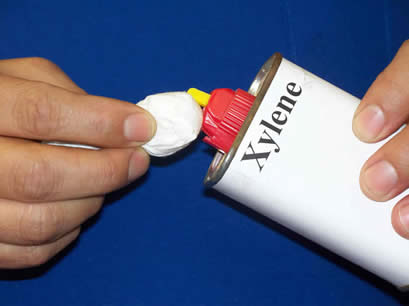Keep both your instrument and bow clean of dust, rosin, oils and dirt.
Cleaning an instrument is often not difficult, but it can be quite expensive. Especially for small repairs, your violin restorer will not just charge for the time the repair takes at the workbench. They have to count the total time including taking in the instrument, making notes of repairs needed, and later writing out the bill and entering the amount in their books. If you can afford not to worry about the expense, great! If the dealer who does the work for you also sold it to you previously, you can probably count on a number of little things without being charged every time. That is good, too. But, if you don’t have money to burn, doing your own cleaning is one of the ways you can prevent weight loss in your wallet.
Caution: Only clean your instrument after completely reading this entire procedure and checking back with your personal professional violin expert.
Instruments with open cracks, especially with new clean cracks should not be cleaned in a normal fashion. Cracks which became dirty this way become much more difficult and expensive to restore satisfactorily. Cleaning an instrument does not necessarily require professional training. The choice of cleaners, however, should be carefully considered with the help of a qualified violinmaker. Not every cleaner can be used on every varnish. Any cleaner with abrasives should be avoided. If you own a modern violin, ask the maker what he recommends.
Many violin restorers use the chemical “Xylene.” This is the generic name and is sold under several brand names in hardware stores. One example is “Xylol.” You can also buy the same ingredient with a different name and a little perfume added for much more money from some violin shops. This chemical is bad for the environment and worse for your health. Therefore, certain precautions should be taken. Xylene will penetrate skin; the vapors can enter your body via lung and eyes. The solution penetrates most gloves, and the one type of glove, which is safe, hinders your dexterity. Don’t let your youngsters do the cleaning themselves. They are more affected by these chemicals. They also may take the precautions less seriously.

At Cauer Violins, we do all the cleaning outside in awell-ventilated area. As soon as we get a little whiff of the chemical, we move a few steps further to avoid exposing ourselves to the fumes. To avoid contact with the liquid, we do the following: We take a sheet of Kleenex, make a wad out of the larger part of it and hold it so that the wad extends outside of our fingers. We put some Xylene on to the lower surface of the bunched up Kleenex and hold it at the dry upper end.
Even though we know that xylene will not harm the vast majority of varnishes, we always carefully try it out on a little area towards the edge. If a clean area becomes sticky, or when the tissue shows color other than the green grey color of violin dirt-rosin-polish, it is advisable to discontinue.
Notable exceptions on which xylene should never be applied are most of the modern Cremonese violins from ca 1980 on, and the violins of the Carl Becker & Son family. The fact that xylene dissolves certain varnishes does not reflect on the quality of the varnish as the beautiful Carl Becker violins aptly demonstrate.
When cleaning a violin while strings and bridge stay in place, we take all precautions that the bridge does not get moved from its place. To facilitate cleaning under fingerboard and tailpiece, we wrap a tissue around a flexible 6-inch ruler and move it carefully up and down under these areas. A coffee stick may work too. When all the dirt is gone, the instrument may show a little semi milky film over the varnish, which gets removed with a soft micro-fiber cloth (or one out of very soft cotton). When buffing it this way, one should avoid pressing in the area of the f flaps. The arching of the top does not support this area, and you can create a small f flap crack from the lower round hole up to the C bout. The cloth used for buffing should not be too large. If too much of the cloth floats around behind the hand like a comet tail, it may get caught in the f hole, at the tuner or at the bridge and damage parts of the instrument. A violinmaker does not buff but polishes the instrument with a liquid, which is a solvent of varnish. The finish is a bit nicer, but it acts as a varnish remover in the wrong hands and should never be attempted by anyone who is not a professional restorer.

